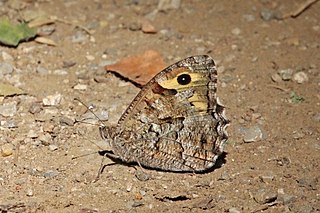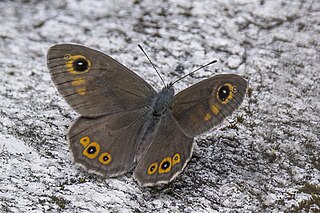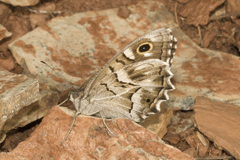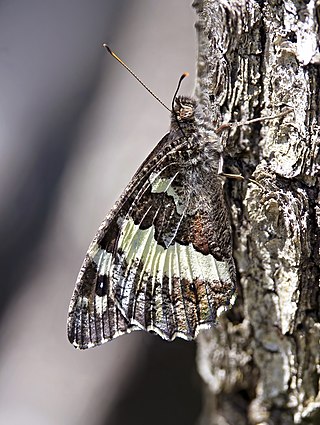
The meadow brown is a butterfly found in the Palearctic realm. Its range includes Europe south of 62°N, Russia eastwards to the Urals, Asia Minor, Iraq, Iran, North Africa and the Canary Islands. The larvae feed on grasses.

The green hairstreak is a small butterfly in the family Lycaenidae.

The grayling or rock grayling is a species in the brush-footed butterfly family Nymphalidae. Although found all over Europe, the grayling mostly inhabits coastal areas, with inland populations declining significantly in recent years. The grayling lives in dry and warm habitats with easy access to the sun, which helps them with body temperature regulation.

Hipparchia is a genus of butterflies within the family Nymphalidae. The genus was erected by Johan Christian Fabricius in 1807.

Lasiommata maera, the large wall brown, is a butterfly in the family Nymphalidae.

The Lapland ringlet is a member of the subfamily Satyrinae of the family Nymphalidae. It is restricted to sunny patches in very damp spruce and pine forests and forested unmanaged peatlands. The larva feeds on various grasses and related plants and winters twice. A dry period in the habitat will result in the decline of the species.

The autumn ringlet is a member of the Satyridae subfamily of the family Nymphalidae. It is a high-mountain butterfly found in the Pyrenees, Alps and in Italy.

Hipparchia hermione, the rock grayling, is a butterfly of the family Nymphalidae. The species can be found in Central Europe, Southern Europe, Eastern Europe, North Africa, Anatolia and the Caucasus.

Hipparchia statilinus, the tree grayling, is a butterfly of the family Nymphalidae.

Coenonympha arcania, the pearly heath, is a butterfly species belonging to the family Nymphalidae.

Coenonympha hero, the scarce heath, is a butterfly species belonging to the family Nymphalidae.

Coenonympha glycerion, the chestnut heath, is a butterfly species belonging to the family Nymphalidae. It can be found in Eastern Europe and east across the Palearctic to Siberia and the Caucasus to North Korea.

Boloria titania, the Titania's fritillary or purple bog fritillary, is a butterfly of the subfamily Heliconiinae of the family Nymphalidae.

Boloria thore, the Thor's fritillary, is a butterfly of the family Nymphalidae. It occurs in damp places in the Alps, Fennoscandia, the south of European Russia, the Urals and east across the Palearctic to Siberia and Japan.

Hipparchia fidia, the striped grayling, is a butterfly of the family Nymphalidae. It is found on the Iberian Peninsula, the Balearic Islands and in south-eastern France and the bordering parts of Italy and North Africa.

Boloria pales, the shepherd's fritillary, is a butterfly of the family Nymphalidae. It is found from the Cantabrian Mountains and the Pyrenees through the Alps and Apennine Mountains east to the Balkan, Carpathian Mountains, the Caucasus and central Asia up to western China.

Erebia pandrose, the dewy ringlet, is a member of the subfamily Satyrinae of the family Nymphalidae. It is found from the Arctic areas of northern Europe, the Pyrenees, Alps, the Apennine Mountains, the Carpathian Mountains, Kola Peninsula and Kanin Peninsula, part of the Ural and the Altai and Sayan Mountains up to Mongolia.

Hipparchia neomiris, the Corsican grayling, is a butterfly in the family Nymphalidae. It is an endemic species confined to the islands of Corsica, Sardinia and Elba. The Corsican grayling flies in July.

Brintesia is a monotypic butterfly genus in the family Nymphalidae and subfamily Satyrinae. Its one species is Brintesia circe, the great banded grayling.

Chazara persephone, the dark rockbrown, is a butterfly species belonging to the family Nymphalidae. It can be found from Crimea across the Caucasus and north of the Middle East to Iran; from the southern Urals across Kazakhstan to the southern Altai and west Siberia.




















